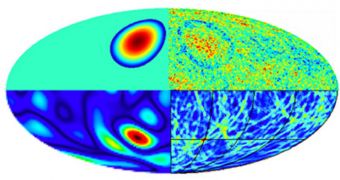Physicists have recently taken an interest in testing to see whether the Multiverse hypothesis is correct or not. This idea holds that the entire Universe is contained within a bubble, which is itself just one of many such bubbles in the Multiverse.
Though this idea has been proposed some time ago, experts are only now beginning to analyze possible ways in which they could go about testing it. If such a large-scale structure were to be confirmed, then the discovery would drastically change our perspective of the Universe.
One of the most important aspects of confirming this idea is searching for the signatures other universes leave behind. The journals Physical Review Letters and Physical Review D recently published two papers that each propose a different way to go about doing this.
Interestingly, theories indicate that bubble universes may collide with each other at times. If that is true, then our Universe should display some telltale signs, such as disk-like ripple patterns in the cosmic microwave background.
The CMB is a layer of relic radiation left over from the time when the Big Bang exploded the Cosmos into being. The event took place about 13.75 billion years ago, and the Universe has been expanding at an ever-accelerating rate ever since.
The NASA Wilkinson Microwave Anisotropy Probe (WMAP) and the European Space Agency's (ESA) Planck missions are already analyzing the CMB in exquisite detail. They are already returning interesting results about the structure of the CMB, which was once thought to be uniform.
Physicists who support the Multiverse hypothesis say that each bubble universe contained within may displays fundamental constants and laws of nature that are different than the ones in the Universe.
Experts at the University College London (UCL), Imperial College London (ICL) and the Perimeter Institute for Theoretical Physics (PITP) have recently taken investigations into their own hands, and began a thorough search for the hypothesized CMB disk patterns.
“It’s a very hard statistical and computational problem to search for all possible radii of the collision imprints at any possible place in the sky. But that’s what pricked my curiosity,” says UCL Department of Physics and Astronomy expert and research coauthor Dr. Hiranya Peiris.
“The work represents an opportunity to test a theory that is truly mind-blowing: that we exist within a vast Multiverse, where other universes are constantly popping into existence,” says UCL PhD student Stephen Feeney, the paper coauthor who created the computer simulations the team used.
One of the gravest challenges the researchers faced was not letting their human nature get the best of them when it came to identifying the large-scale structure in the CMB.
“It's all too easy to over-interpret interesting patterns in random data, so we took great care to assess how likely it was that the possible bubble collision signatures we found could have arisen by chance,” ICL Department of Physics expert Dr. Daniel Mortlock concludes.

 14 DAY TRIAL //
14 DAY TRIAL //